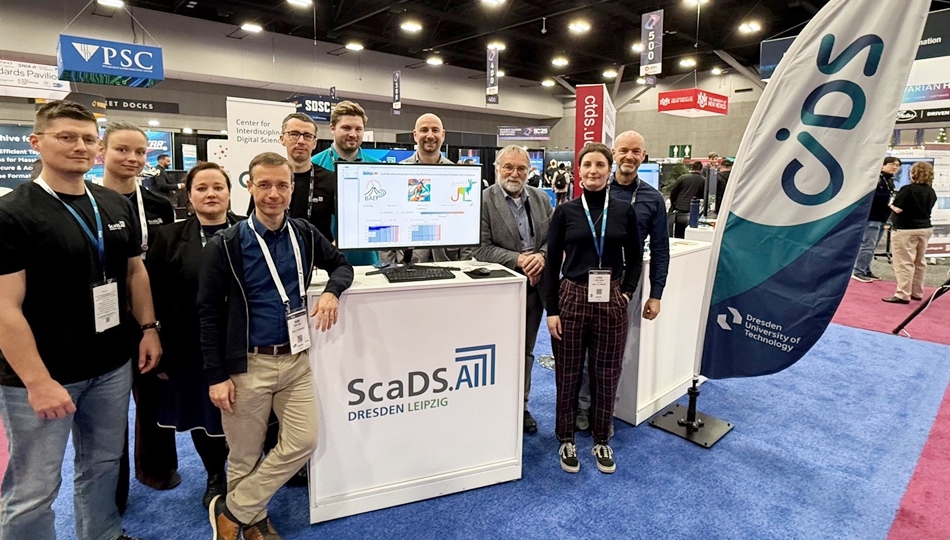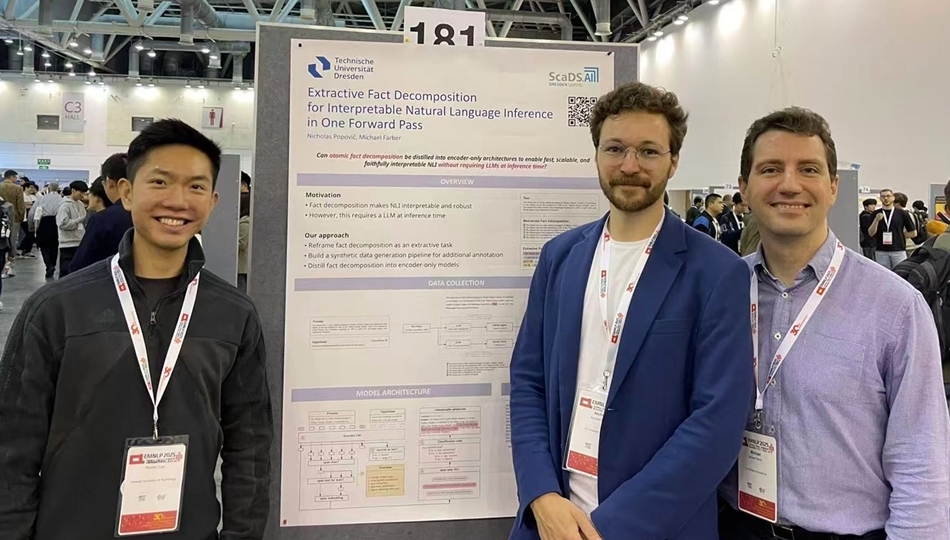
October 22, 2024
Generative AI, Responsibility, and Creative Work: Animating Tomorrow

On 22.10.2024, the Animating Tomorrow animation film conference took place at Puschkino in Halle (Saale). ScaDS.AI Dresden/Leipzig team member Vanessa Kuhfs was invited as a panel speaker. She shared insights from her research on the application of generative AI in the media industry and offered a practical, critical perspective as an independent filmmaker and designer. Animating Tomorrow provided an ideal platform for networking, professional development, and fostering informed perspectives on AI in the creative field for both emerging talents and experienced professionals.
Supporting and Training New Talent
A core objective of Animating Tomorrow was to ease the entry of young talents into the animation industry. Through various showcases, industry professionals from film, series, agencies, and freelance backgrounds shared hands-on insights into their fields. They discussed the technical and creative competencies required for a successful career in animation, particularly in light of rapidly advancing technology and the growing use of AI-driven tools.
Future Frames: A Discussion on Artificial Intelligence
A highlight of Animating Tomorrow was the closing panel, Future Frames, in which Vanessa Kuhfs discussed the intersection of AI research and design practice. This interdisciplinary panel explored how AI is reshaping creative work and the new possibilities and challenges it presents. It featured experts in XR/VR, film production, direction, and animation.
Following an introductory presentation on generative AI in the creative industries, the participants discussed the implications of technological innovation for the film sector: Is AI a threat to existing jobs? Is AI an opportunity for new forms of creative expression? The discussion actively engaged the audience, fostering an open exchange of fears and hopes about AI and exploring responsible ways to integrate this technology.
AI in the Production Pipeline: Successful Integration and Challenges
Vanessa Kuhfs highlighted both successful cases and challenges in implementing AI within the production pipeline. While AI opens up new creative possibilities, it also raises complex ethical and practical questions about fairness and responsibility in the media industry.
Preproduction and Writing
One high-profile area where AI shows promise is storytelling. Swiss filmmaker Peter Luisi experimented with ChatGPT to write the entire script for The Last Screenwriter. Ironically, the film centers on a screenwriter who is outperformed by AI, aiming to spark an important debate on AI’s role in creative work. Yet, due to negative feedback, the premiere in London was canceled, losing a key opportunity for dialogue on AI in the arts.
Major studios and research teams, like Pixar and Disney Research, are actively developing proprietary models and AI-driven pipelines. An example is Disney’s text-to-animation tool, which generates storyboards directly from scripts. Similarly, platforms like Cinelytic.com assist with logistical planning and preproduction. This blend of creative potential and societal hesitation underscores a critical question: How far should AI integrate into creative processes? Luisi’s film, along with recent Writers Guild of America (WGA) protests, illustrates this ambivalence. The WGA secured an agreement that ensures human creativity remains valued and protects writers’ rights in a technology-driven industry.
Production
The 2023 labor disputes in Hollywood continued beyond the WGA strikes, with SAG-AFTRA actors concerned about replacement by AI-generated avatars. Avatars created through actor scans can be reused across multiple films, prompting negotiations that secured a three-year agreement protecting performers from such risks, including compensatory measures and mandatory consent for using digital replicas. These protections narrowly averted a real-world scenario reminiscent of Black Mirror’s Joan is Awful.
Art Department and Animation
In the art and animation fields, AI enables fast, high-quality outputs, including storyboards, backgrounds, character designs, rigging, style transfer, AI-driven motion capture, and even fully automated animations. However, artists like Greg Rutkowski, known for his unique style, face challenges from style modifiers that replicate their techniques without attribution or compensation. Despite attempts to remove his style from open-source tools like Stable Diffusion, resistance from the community highlights the difficulty artists face in protecting their digital identities. Platforms like Artstation, initially used to promote digital art, have limited support for artist protests against AI use, even removing protest works from their platform in response to changing terms.
This situation not only threatens individual livelihoods but also risks a homogenization of creative processes. AI models trained on popular styles could reduce the diversity and originality in film and art, pushing unconventional projects to the margins. The influx of synthetic media—content generated or altered by AI—compounds this issue, as these data sets continuously feed into future AI training, leading to a phenomenon known as model collapse or data entropy, where repetition diminishes quality (Garbage in – Garbage out).
Creative Integration and the Role of Artists
Creatives are more than content creators—they are ideal collaborators for developing prompt engineering and refining AI-driven workflows. Their knowledge of composition, lighting, and artistic intuition remains essential to producing high-quality synthetic media. Rather than viewing AI as a threat, creators should be actively engaged and trained to adapt to AI-integrated production workflows.
The pipeline also extends to postproduction, where VFX, 3D modeling, color correction, matchmoving, and other processes are becoming increasingly automated. This accelerated shift is both exhilarating and anxiety-inducing, as it brings an array of opportunities and challenges to the industry. Focusing solely on dystopian narratives, however, overlooks the creative and operational advantages AI can offer.
Some artists are leveraging open-source tools like Stable Diffusion to create and monetize custom AI models of their own style. With that, they are gaining a competitive edge and new revenue streams. This approach enables artists and small studios to bring creative visions to life without major studio resources. Furthermore, the technology introduces fresh aesthetics and forms of expression. It remains to be seen whether audiences will tire of AI-generated content or embrace it as a distinct art form. The potential for a renewed appreciation of traditional filmcraft alongside AI-driven innovation offers a glimpse into the future of media.
Interdisciplinary Exchange and Networking at Animating Tomorrow
Animating Tomorrow created a unique space for exchange between emerging talent, industry veterans, and researchers. It emphasized and encouraged interdisciplinary collaboration between research and design practice. The panelists underscored that a responsible, well-considered use of AI in media production can only be achieved through cross-disciplinary cooperation. Conferences like these play a crucial role in preparing the film and animation industries for the future, helping to navigate the shared opportunities and challenges posed by Artificial Intelligence.

The conference encouraged participants to critically and creatively evaluate the potential of AI technology, fostering a view of AI integration as both a technical and a creative asset. It was organized by hug films GbR in collaboration with AG Animationsfilm. The Mitteldeutsche Medienförderung and the state of Saxony-Anhalt supported Animating Tomorrow. Learn more about the conference here.
You will find further information on this topic in the 3rd issue 2024 of the film and media journal “Auslöser”. Download issue 3/24 here:






